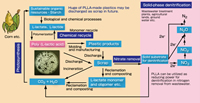Research highlights
Toward a new earth-friendly resource circulation system for poly(L-lactic acid)
Poly(L-lactic acid) (PLLA) is attractive for use as a biodegradable plastic material that can be employed for general use instead of petroleum-derived plastics. Since it is estimated that a large amount of waste is discharged along with the diffusion of PLLA chains, an effective way of using PLLA waste is necessary to establish a new earth-friendly resource circulation system.
A promising method involves the use of PLLA instead of general-purpose exogenous soluble substrate, such as methanol, as the reducing power for denitrification in nitrogen removal from wastewater.
However, much less effort has been directed towards the use of PLLA in denitrification processes because of the low biodegradability. In fact, the nitrate removal property of denitrification processes with PLLA has been shown to be much lower than that of other biodegradable plastics such as poly(3-hydroxybutyrate-co-hydroxyvalerate) and poly(ε-caprolactone).
Here, Takeshi Yamada and collegues at Department of Environmental and Life Sciences, Toyohashi University of Technology report on the use of PLLA waste as external electron donors in denitrification processed by changing its weight-average molecular weight and microbial communities that are responsible for the PLLA-added denitrification processes.
The researchers prepared PLLA pellets of Mw of 45,100, 12,000 and 9,900 operated denitrifying reactors for 2 months, which contained activated sludge as the seed and 1 % (as reactor volume) of PLLA as the substrate. The population dynamics of denitrifying bacteria in the reactors were investigated by cultuire-dependent and culture-independent polyphastic approaches with nonmetric multidimensional polyphasic approaches.
PLLA having an Mw of approximately 10,000 is suitable for the denitrification process, offering good nitrate removal efficiency. The culture-independent approaches with statistical analyses and culture-dependent approaches suggest that bacteria belonging to family Comamonadaceae predominated and played a role in denitrification in the wastewater treatment processes. Also, nitrate removal property of the denitrication reactor with PLLA is attained through the bioavailability of hydrolysates released abiotically from the PLLA.
This study showed a suitable adjustment condition for the use of PLLA wastes as an external electron donor in denitrification processes. In addition, a large potentiality of PLLA was shown as an earth-friendly biodegradable plastic.
- Reference:
- Authors: Masaaki Takahashi, Takeshi Yamada, Motohiro Tanno, Hideto Tsuji and Akira Hiraishi.
- Title of original paper: Nitrate removal efficiency and bacterial community dynamics in denitrification processes using poly (L-lactic acid) as the solid substrate.
- Journal, volume, pages and year: Microbes Environ, 26, 212-219 (2011).
- Affiliations: Department of Environmental and Life Sciences, Toyohashi University of Technology.
- Department website:
 Fig1:A new earth-friendly resource circulation system for poly(L-lactic acid)(PLLA),suggested by authors.
Fig1:A new earth-friendly resource circulation system for poly(L-lactic acid)(PLLA),suggested by authors.
Enlarge Image
 Takeshi Yamada
Takeshi Yamada
Enlarge Image


